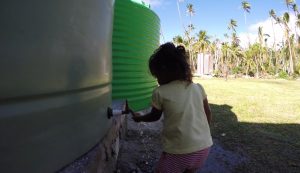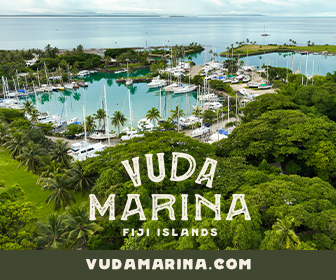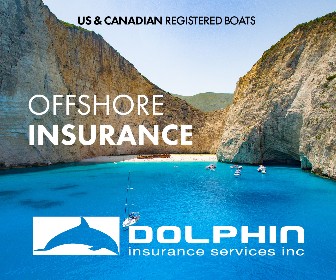Fiji: Sea Mercy’s work in the Lau Group after Cyclone Winston.
Named the Exploring Isles by a U.S survey expedition in 1840, the closest of the islands in Fiji’s Lau Group lies over 100nm. to windward of the country’s nearest Port of Entry and a 2-day ferry trip from the capital, Suva. Until 3 years ago cruising yachts were not permitted to visit.
Published 8 years ago, updated 9 months ago


Cyclone Recovery in Northern Lau by Jonathan Robinson, Sea Mercy Coordinator
In the wake of Cyclone Winston’s 320km/h (200mph) winds, torrential rain, and waves of up to 12m (40ft), Fiji’s National Disaster Management Office (NDMO) requested Sea Mercy’s assistance with their recovery. Not only were logistics going to be a challenge to our fleet of small sailing vessels, but the very presence of the yachts was doubtless going to have a significant cultural impact upon these remote island communities.
Over 60 Volunteer Cruising Boats
Australian and New Zealand warships first responded in Koro Island and Northern Lau, identifying the area around Vanua Balavu as one of the worst hit. By late March they had completed their relief mission and information reports from the region had dried up.
Many volunteer cruisers, ourselves included, were spending cyclone season in New Zealand. With the situation in Lau now unknown we decided to muster vessels in Opua, New Zealand’s northernmost Port of Entry and take the first acceptable weather window to make the 1200 nm. passage directly to Northern Lau. A sufferance clearance port would be established at Lomaloma in Vanua Balavu, with customs, immigration and biosecurity officials being flown in from Suva on the weekly flight. Fuel drums and aid would be pre-positioned for us by ferry from Suva.
With the number of volunteer vessels exceeding sixty, recovery plans were designed, wherever possible, to fit into and around individual skippers’ sailing preferences. Consequently “rotations” of vessels were developed allowing crews to participate in different projects in various locations then releasing them to continue cruising as other vessels filled their place.
Departure from NZ Mid-May
The first eight vessels departed Opua in mid-May, arriving Fiji via Minerva Reef ten days later. Within 36 hours we had been cleared in, syphoned the diesel drums dry, distributed the pre-staged aid supplies and were heading out to conduct Needs Assessment Reports on the most at risk islands.
During our recovery work in Vanuatu last year, following the devastation caused by Cyclone Pam, a village Chief had commented: “This year we had two cyclones. Cyclone Pam and then a cyclone of 1000 people with clipboards.”
Our Sea Mercy crews don’t carry clipboards.
The New Zealand military had done an impressive job of immediate response in the major settlements on Vanua Balavu, but the smaller island communities were still in very poor shape. As a primary school teacher, standing before the ruins of what was once her school, told me “There is no-one helping our community, only your organization.”
Priorities following a disaster
Water, Sanitation and Hygiene (WASH) are the established priorities following any disaster. The detailed needs assessment reports by Sea Mercy skippers and crew allowed us to narrow down the original NDMO target list to 14 communities and 8 schools on the islands of Vanua Balavu, Avea, Cikobia, Munia and Susui. A total population of around 1200 people.
Rapid prioritization of each community’s requirements allowed speedy aid requests to be submitted and donated funds were spent in Fiji to assist with the economic recovery. Subsequent deliveries by infrequent island ferries would, however, take time.
Chiefs, Headmen and community leaders were away in Suva, awaiting government rebuilding funds. The main copra plantation was out of action for at least 2 years and many fishing boats had been damaged or destroyed. Fishing gear had been swept away and family subsistence gardens flattened.
With their men away, with no income and with only the occasional fish for protein, the women had attempted to supplement emergency government rations by replanting their gardens with donated seeds. An infestation of caterpillars, previously unknown in these islands, had followed. The few surviving plants were at risk of destruction by wild pigs.
Morale was low, some communities were leaderless, many women and children were in tears.
In the outer islands of Avea, Cikobia and Susui, there was a critical shortage of drinking water. These islands rely on rain catchment from roofs over the summer to store sufficient water to sustain them through the dry season. With 80% of this catchment destroyed their reserves were dangerously low.
Avea Island villagers had hand dug a well but, being close to shore, it produced only undrinkable, brackish water.
Susui Island has a freshwater spring, which historically dries in the winter. The spring, now a mere bubble, was contaminated by coliform bacteria. A Sea Mercy skipper produced long term plans to reclaim the spring head and clean the water, but a short term solution was urgently needed.
In dire circumstances in the past, the people of Cikobia Island had relied upon a spring that is accessible only at low tide. In order to access the water, the villagers needed to dig down through a meter of sand to the clear water below. The water was then scooped up into small buckets and carried across the island to the village.
Although Sea Mercy vessels did what they could, running their own small desalination units and ferrying the precious water ashore in jugs, they needed a better solution.
A generous donor had made funds available for Sea Mercy to construct a landing craft with a desalination unit aboard, but the newly launched vessel was over 250 sea miles away and already committed to other Sea Mercy projects.
Water, Repairs and Lives Rebuilt
Enter the first of three superyachts to rally to the cause.
In less than three days they delivered over 15,000 litres of water to the thirsty islands. In their “spare time” they repaired and repainted Lomaloma hospital’s damaged children’s and labour wards.
Sea Mercy crews installed a solar-powered desalination unit in Avea.
While demand still exceeded supply, water insecurity fears had been temporarily ameliorated.
The Irish poet W.B Yeats famously wrote “I have spread my dreams under your feet.
Tread softly because you tread on my dreams.”
Every village took a sponsor vessel, whose crews became deeply and often emotionally involved in their community.
Mindful of village sensitivities and working under the watchful direction of their sponsors, teams of cruisers cleared village paths, chainsawing and milling the deadfall to construct shelters.
They erected pig-proof fencing around gardens, delivered a programme of gardening education, introduced composting techniques and developed, mixed and delivered an organic pesticide that successfully removed the caterpillar scourge.
Fibreglass fishing boats were repaired when possible, and new wooden ones would be built from scratch.
When the first ferry load of aid arrived it felt like the whole of Vanua Balavu turned out to assist with the offload. Timber, roofing iron, gutter kits, biosecure seeds, fishing gear, and boat repair and construction materials, were just some of the items that were loaded into local trucks and island longboats.
It was the first of many long but rewarding days and nights spent on the wharf at Lomaloma.
Impact on Children
Visiting Fijian psychiatric counsellors expressed their concern over the impact that the cyclone had had on the children. Before Winston, there had been seven primary schools and one secondary school in our area of concern. Only two schools had survived. Children were being taught in abandoned house ruins and UNICEF tents that rattled and shook whenever the wind blew, distracting and then scaring the students.
One of our skippers wrote: “When we first arrived, we visited a school, and a little girl of 5 or 6 spontaneously started to cry loudly when she saw us arrive. We were told by the headmaster that children sometimes associate “white people” with disasters such as cyclones. Because that is when the “white people” all arrive: right after such events! This little girl had been traumatized and, upon seeing us all arrive, she was reminded of the terrible day of the storm…or perhaps she’d feared the worse: another cyclone!” s/v Amelie IV.
The vessels with children onboard sent them into action. Shared lessons and sports put smiles back on sad faces, although the finer points of rugby remain a mystery to our North American children.
Nearly every school library had been destroyed. “Boat schooling” educational materials were downloaded onto 64G memory sticks and given to every head teacher. Additional requests for school sports and safety equipment were submitted.
While a cruising family educated and entertained the children with puppet show performances that rivalled any Jim Henson production, an American teenager and her mother shipped 300 pairs of “The Shoes That Grow.”
Later, while distributing a pair to every primary school child, we realized that this was less about the footwear and more about the compassion shown to these children by a mother and daughter from the other side of the world.
More support from the Cruising Community
Our initial fleet had been temporarily reinforced by vessels of the World ARC rally who, through their “Raise Your Waterline” initiative, donated items ranging from saucepans to solar panels.
Additional vessels beat to windward against the strengthening trade winds, to deliver bags of donated clothing, sorted and loaded by volunteers.
Upon arrival from New Zealand, still more volunteer vessels had sailed directly to other Sea Mercy projects: building a school in Makogai, a water project in Batiki, delivering aid to Taveuni and servicing Sea Mercy desalination units in the Yasawas.
The original group of vessels, with whom we had sailed from New Zealand, rotated out of Lau and for part of July, we alone were privileged to sail these beautiful cruising grounds.
An extract from my report of July 1 reads:
“Susui Island reports only 1 week’s reserve of water remaining. Rationing remains in place at one bucket per household per day…Further water deliveries are urgently needed…..The Provincial Health Officer expressed her concerns to me over sanitation (in other villages)….long drop drums….are reported nearly full with no replacements.”
I became overly familiar with the construction of “pour flush privy” water seal toilets. Cement and wire mesh was ordered and shipped for construction, moulds were transported to affected villages and empty fuel drums, for the surviving traditional “long drops,” sourced and delivered.
Winston had plunged many communities into darkness, destroying their few existing solar panels, batteries or generators.
A second superyacht generously donated a solar power pack to each household on Avea Island through Sea Mercy’s “LIGHT A VILLAGE” initiative. Many other communities remain less fortunate and, with no immediate prospect of assistance, further donations for this cause are still desperately needed.
Deliveries of our requested aid supplies continued and passing cruisers assisted our limited water making efforts. While every ferry offload was a social occasion and the interaction with fellow cruisers a pleasant interlude, the shortage of fresh water remained the major obstacle to a successful recovery.
A third visiting superyacht donated and delivered a water filter for every household at risk from contaminated spring water, but Susui Island’s spring was all but dry.
Sea Mercy’s Desalination Unit Arrives
Sea Mercy’s landing craft, with its sizeable desalination unit, had been operating flat out since its recent launch. A crossing of the Koro Sea in such an uncomfortable vessel, this late in the season, was definitely not for the faint of heart. The skipper was undeterred.
In early August, despite the weather necessitating an inventive choice of the route into the reef system, the barge finally arrived. Supported by a returning Sea Mercy vessel, the crew set about the desalination and delivery of over 100,000 litres of water to the dehydrating islands.
Six months after Winston and the recovery were underway.
Government building materials were beginning to be shipped in, complimenting those which Sea Mercy had already provided. Village vegetable gardens were producing, water catchment systems had been repaired and fishing boats refloated. Toilets were under construction and the New Zealand High Commission had invited tenders to repair or rebuild all but one of the damaged schools. The children in the outer islands now had sports equipment, sports uniforms and lifejackets for their often hazardous open boat voyages to Vanua Balavu.
Sea Mercy’s Floating Healthcare Clinic vessel was on station and everyone now had enough clean water to see them through until the rains.
It was time to leave.
Three and a half months after sailing from Opua, my wife and I bid an emotional farewell to the people of Northern Lau.
Around 50 cruising vessels sailed through the waters around Vanua Balavu during our time there, almost 80% contributed to Sea Mercy’s recovery effort. Some stayed for 6 weeks, others a few days. Three pulled “double duty,” departing to return with fresh crew and supplies – and several generously raised their waterline as they passed through. Cruisers in other ports spent long days sorting warehouse aid before sailing to support the recovery efforts in other locations.
Within 24 hours of Winston’s impact, Sea Mercy crews were the first on the ground………. they were also the last to leave.
I have not named names, there are too many people to thank. Every single crew member and volunteer should be proud of their contribution.
Nobody signed on to Sea Mercy in search of fame or recognition and much of what they did will remain untold.
Their reward was found in the eyes, hearts, smiles and songs of the people of Fiji.
Find out more about Sea Mercy at http://www.seamercy.org/
Related to following destinations: Fiji
Related to the following Cruising Resources: Cruising Impact, Cruising Information, Environment








Well done and well written Jonathan…..great effort by all…